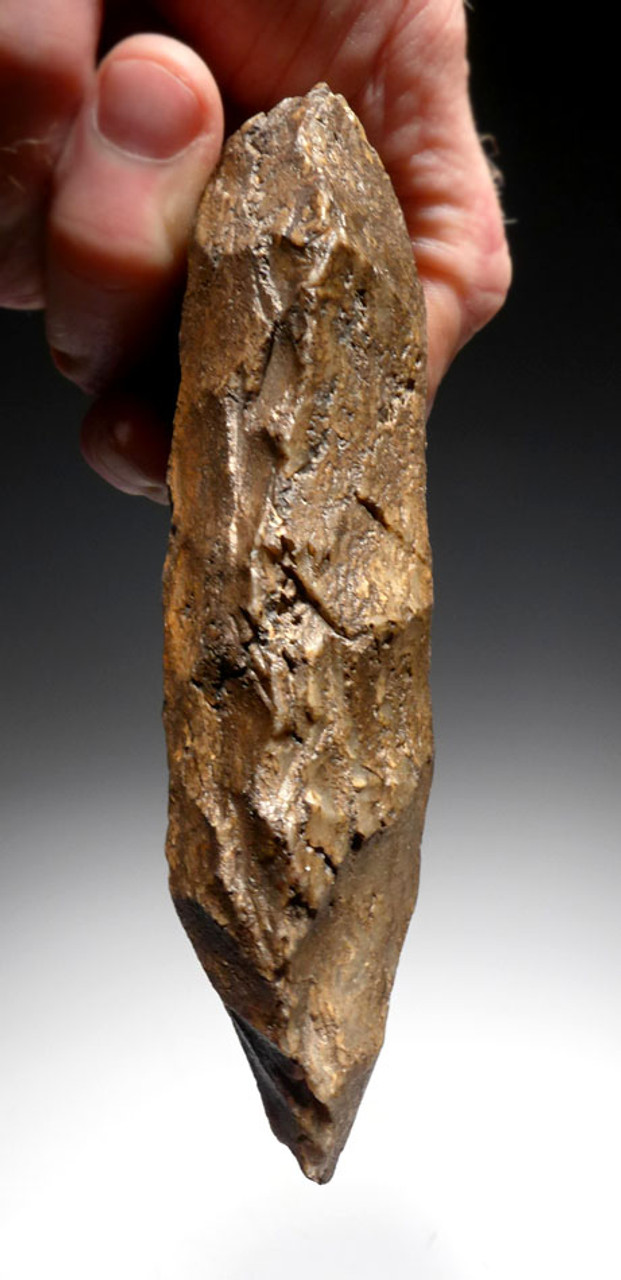Product Description
This GENUINE bifacial hand axe was made and used by early humans of the primitive species Homo erectus (ergaster). It was surface-collected from an exposed Lower Paleolithic Acheulian site in the Sahara Desert of North Africa. This Lower Paleolithic tool represents the first scientifically documented intelligent design made by primitive humans. Prior to these Saharan Acheulian handaxes, only crude pebble and flake tools existed in the human fossil record.
This is a RARE, MUSEUM-CLASS example of an Acheulian hand axe form known as an AMYGDALOID BIFACIAL hand axe. Whereas the vast majority of these Northern Sahara Acheulian hand axes are made of quartzite, this exquisite specimen was flaked out of TABULAR CHERT. The harder material sustained the millennia of desert exposure better than quartzite, preserving the AMAZING flaking and workmanship RARELY SEEN hand axes of this period. Both flat faces of the axe are the original outer cortex of the un-flaked faces of the original slab of chert. This made for an ingenious way to best grip the hand axe as this surface was naturally rougher than any other stone of the region. The flaked proximal end has a recessed area for the palm with flaked recesses for the fingers, when held. The chopping tip and edges are unusually sharp and amazingly, have survived UNBROKEN. Every aspect of this PRIZE specimen is intact and well-made with evidence of original prehistoric primary and secondary flaking. This hand axe is complete and in "as found" ORIGINAL condition with NO REPAIR AND NO RESTORATION.
Surface areas of the tool display a "desert varnish" - a natural glossy surface where the artifact lay undisturbed and exposed to blowing sands, for millennia. The wind-driven sand polished and deposited microscopic layers of silica on the surfaces of the artifact, giving it a sheen. In many cases, a bi-colored patina on either side, also developed, as the exposed side patinated differently than the unexposed side. Original sediment and mineral encrustations are still present in microscopic crevices and cracks - a trait ONLY found in authentic Paleolithic artifacts like these. These features are a testament to the age and authenticity of ALL Saharan Paleolithic artifacts.
During this time in prehistory when this Lower Paleolithic tool was made, the Sahara Desert (where this stone tool was found) was a savanna rich in wildlife. Prior to the prehistoric global warming that turned the vast region to desert, early humans lived alongside prehistoric giraffe, bison and elephant, which were vital to their survival. Hunting and butchering these animals would have required specialized tools such as those found in the Acheulian Period.
 US DOLLAR
US DOLLAR
 EURO
EURO
 AUSTRALIAN DOLLAR
AUSTRALIAN DOLLAR
 CANADIAN DOLLAR
CANADIAN DOLLAR
 POUND STERLING
POUND STERLING
























